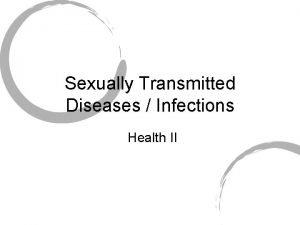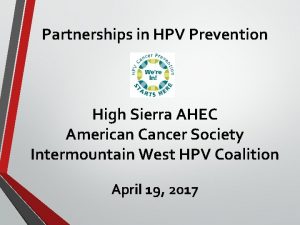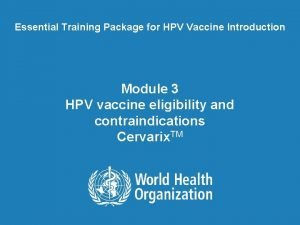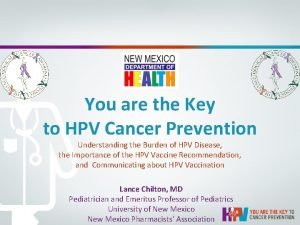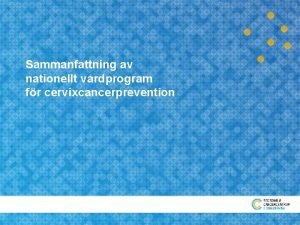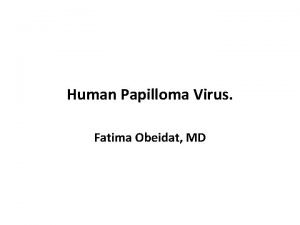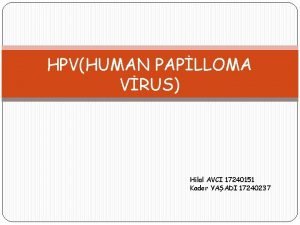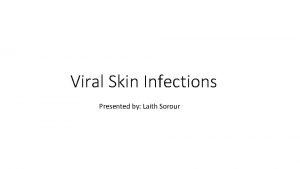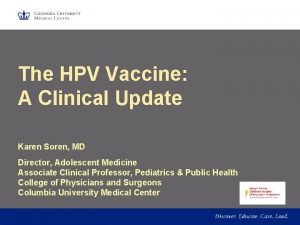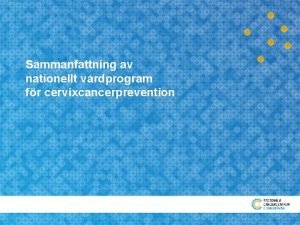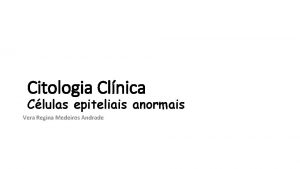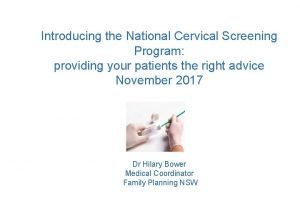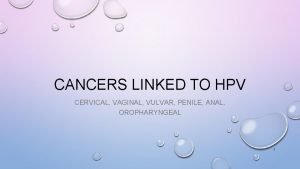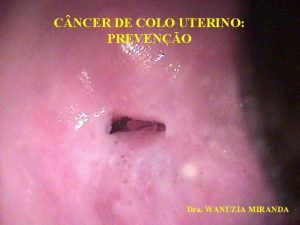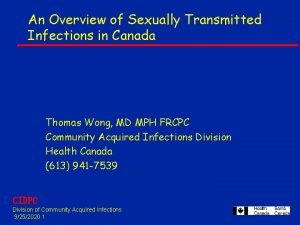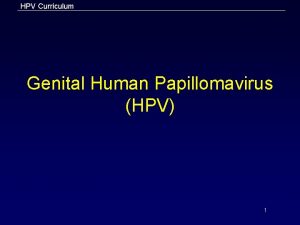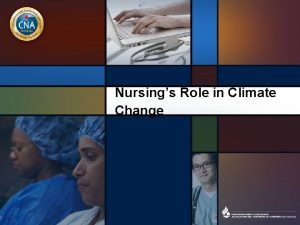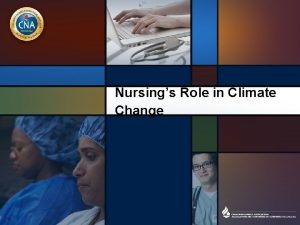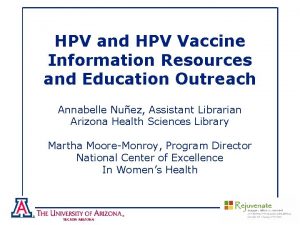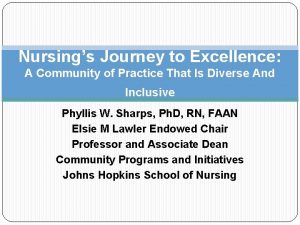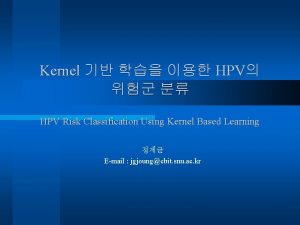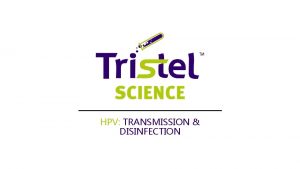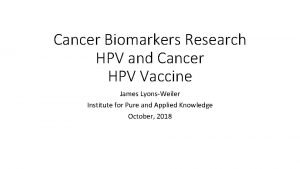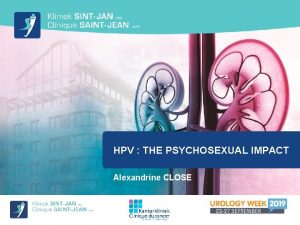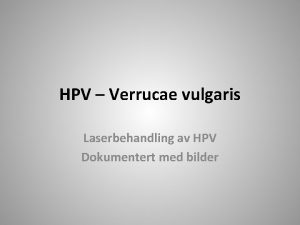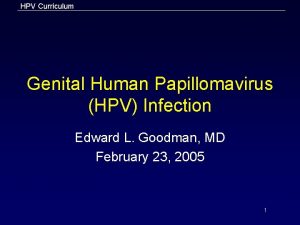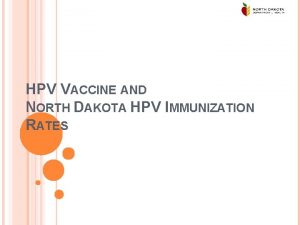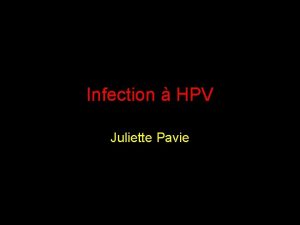PLANNED COMMUNITY CHANGE Nursings Role in HPV Education























- Slides: 23

PLANNED COMMUNITY CHANGE: Nursing’s Role in HPV Education and Immunization Kent County, Michigan By: Nicole Keech, Yvonne Koolman, Jenny Parish, Cheryl Klinkner, and Brenda Peruski

Human Papillomavirus Known to be the most common cause of STD’s through out the world. � More than 100 types of HPV have been identified. � HPV can be transmitted though common sexual intercourse and through non-penetrating sexual activities. �

HPV continued… Some may cause common skin warts. � “High Risk” viruses may cause abnormal Pap Smear results and lead to cancer of the cervix, vulva, vagina, anus or penis. � “Low Risk” viruses will cause mild abnormal Pap smear results or genital warts. �

PROBLEM STATEMENT Male and females under the age twenty six, are at an increased risk of reproductive organ cancers due to HPV transmission related to lack of Human Papillomavirus (HPV) vaccination as evidenced by… Increasing rates of new cervical cancer diagnosis in women � Penile and rectal cancers in men � Low rates of female vaccination as well as almost nonexistent vaccination rates for males. �

How common is HPV and related diseases? � 1) Health experts estimate that there are more cases of genital HPV infection than any other sexually transmitted disease (STD) in the United States. 2) According to the American Social Health Association, approximately 5. 5 million new cases of sexually transmitted HPV infections are reported every year, though 6. 2 million new infections are estimated to occur. 3)At least 20 million people in the United States are already infected -- most of them may not even know it.

Continued. . 4)Genital warts. About 1% of sexually active adults in the U. S. have genital warts at any one time. � 5)Cervical cancer. The American Cancer Society estimated that in 2008, 11, 070 women will be diagnosed with cervical cancer in the U. S. � 6)Other HPV-related cancers are much less common than cervical cancer. The American Cancer Society estimated that in 2008, there was: • 3, 460 women diagnosed with vulvar cancer; • 2, 210 women diagnosed with vaginal and other female genital cancers; • 1, 250 men diagnosed with penile and other male genital cancers; and • 3, 050 women and 2, 020 men diagnosed with anal cancer. �

Statistics Estimated Number of New Cervical Cancer Cases, Michigan 2011 New Cases* 360 *Excludes in situ carcinomas. Note: Numbers are rounded to the nearest 10. Cervical cancer mortality estimates are not available.

Statistics Cervical Cancer Mortality Rates, Michigan 2008 vs. US 2007 Number in Age-Adjusted Rate* Michigan (2008) US-SEER (2007) Total 116 2. 0 2. 4 Whites 86 1. 8 2. 2 Blacks 25 3. 4 4. 4 *Rate per 100, 000 race and gender-specific population.

Statistics Cervical Cancer Five-Year Relative Survival Rates by Stage at Diagnosis, Age and Race, US 20012007 All Races White Black All stages 68. 6 70. 0 58. 4 Localized 90. 9 92. 1 83. 1 Regional 57. 0 58. 0 51. 9 Distant 18. 7 19. 8 13. 3 Unknown 53. 7 53. 0 51. 9

PREVENTION The ONLY prevention in HPV is abstinence. *******NO SEX****** ONCE YOU DO…… YOU ARE AT RISK!!!!!!

REDUCING THE RISK � • Use a Condom during the entire sexual interaction � • Decrease number of sexual partners � • Remain in a committed Relationship � • Get the HPV vaccine series

REDUCING RISK CURRICULUM � The Curriculum Covers: › An overview of STDs, HIV, abstinence and birth › › control methods How to obtain and use contraception Risks and consequences of sexual activity Decision making, negotiation and refusal skills Tactics to prevent & delay sexual activity Strategies to strengthen parent-child communication

Barriers to Prevention Lack of knowledge related to risk factors and prevalence of disease � Lack of knowledge preventative measures such as: vaccination, abstinence, and condom use � Fear of an adverse vaccination reaction � Cost �

The Health Belief Model � In this model, health-promotive action is based on four beliefs: Individual perception of ones susceptibility or risk 2. Perceived seriousness of the disease 3. Belief that the disease can be prevented 4. Benefits of the health promoting action outweigh the barriers 1.

Nursing’s Role � How nursing can help increase the demand for and use of health education and immunization services for HPV? • Educate the population to understand their risk and the consequences of infection. • Encourage use of interventions and have good counseling skills. • Help to portray that positive images of the HPV vaccine are featured in the media and in community consciousness. • The Vaccine is readily available as part of reliable, high quality health services.

Nursing’s Role Continued… Patient reminder systems are in place. � A supportive policy environment exists, for instance the vaccination is required for school entry and subsidized services are available for the poor. � Ensure that the patient’s out-of-pocket costs are minimal �

HPV Vaccination Gardasil, a quadrivalent vaccine, is the first licensed vaccine developed to prevent cervical cancer and other diseases in females who are infected with HPV. � Protects against four HPV types (6, 11, 16, 18) which are the main types responsible for cervical cancer and genital warts. � It is administered through a series of three IM injections over a six month period (at 0, 2, and 6 months) �

FEMALES FDA approved a Vaccine to prevent HPV in Females � � � � • 2006 Cervarix and Gardasil was approved for female only • Cervarix Prevents HPV Infections Type 16 and Type 18 • Gardasil Prevents HPV Infections Type 6 and Type 11 • Recommended for 11 and 12 year old girls • Recommended for Females age 13 to 26 • Prevents 70% of all cervical cancers • Prevents 90% of genital warts

MALES FDA approved a Vaccine to prevent HPV in males � • Gardasil was approved for males in October 2011 � • Recommended for boys as young as age 9 � • Better results if given before sexually active � • Recommended for Males between ages of 11 and 21 � • Also Recommended for Males between ages of 22 and 26 who have never been vaccinated

Evaluation Desired Outcome � A reduction in the number of new cases of HPV vaccine preventable diseases.

EVALUATION Measureable Objective � We can measure the effectiveness of our interventions by tracking the vaccine rate in our target population.

References Centers for Disease Control and Prevention. (2011). HPV Vaccine Information for Clinicians-Fact Sheet. Retrieved from CDC: http: //www. cdc. gov/std/HPV/STDFact-HPV-vaccinehcp. htm � Clark, M. J. , (2008). Community Health Nursing: Advocacy for population health. Upper Saddle River, NJ: Pearson Prentice Hall. � Goldrick, B. (2012, p. 258 -260). Risk of Infectious and Communicable Diseases (Chapter 13) Community and Public Health Nursing Evidence for Practice. Eds. Harkness, G and De. Marco, R. New York: Lippincott Williams &Wilkins �

References Continued… National Institute of Allergy and Infectious Disease. (2010). Human Papillomavirus (HPV) and Genital Warts. Retrieved from National Institute of Allergy and Infectious Diseases: http: //www. niaid. nih. gov/topics/genitialwarts/understanding/P ages/prevention. aspx � Sherris, A. , Friedman, J. , Wittes, s. , Davies, P. , Steban, M. & Salaiba, M. , (2006). Science Direct. Education, Communication, and Training for HPV Vaccines. PDF file Retrieved from http: //rho. org. whsites. net/files/Vaccine_24_S 3_ch 25. pdf � Stoto, M. A. , & Cosler, L. E. (2012). Evaluation of Public Health Inteventions. Retrieved from http: //www. jblearning. com/samples/0763738425/38425_CH 1 8_495_544. pdf �
 Planned economy or planned destruction political cartoon
Planned economy or planned destruction political cartoon Critique of planned change
Critique of planned change Grandfolkie planned change theory
Grandfolkie planned change theory Planned change process steps
Planned change process steps Nature of planned change
Nature of planned change Any planned combination of education political
Any planned combination of education political Any planned combination of education political
Any planned combination of education political Hpv test for men
Hpv test for men Hpv oral cancer
Hpv oral cancer Hpv vaccine schedule adults
Hpv vaccine schedule adults Hpv cancer prevention
Hpv cancer prevention Hpv dna testi
Hpv dna testi Ascus hpv negativ
Ascus hpv negativ Does hpv go away
Does hpv go away Hpv tipleri
Hpv tipleri Hpv type 16 and 18
Hpv type 16 and 18 Hpv type 16 and 18
Hpv type 16 and 18 Atypii
Atypii Meninkok
Meninkok Hpv
Hpv Cancerscreening.gov.au
Cancerscreening.gov.au Hpv cervical cancer
Hpv cervical cancer Wanzia
Wanzia Hpv cervical cancer
Hpv cervical cancer







